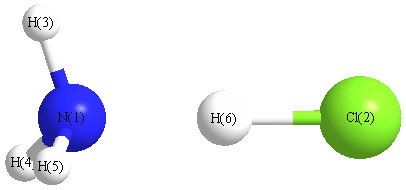Vibrational Frequencies calculated at HF/3-21G
| Mode Number |
Symmetry |
Frequency
(cm-1) |
Scaled Frequency
(cm-1) |
IR Intensities
(km mol-1) |
Raman Act
(Å4/u) |
Dep P |
Dep U |
|---|
| 1 |
A1 |
3583 |
3245 |
42.42 |
73.72 |
0.05 |
0.10 |
| 2 |
A1 |
1847 |
1673 |
3810.57 |
205.57 |
0.27 |
0.43 |
| 3 |
A1 |
1521 |
1378 |
53.11 |
9.42 |
0.35 |
0.52 |
| 4 |
A1 |
380 |
345 |
163.72 |
1.16 |
0.55 |
0.71 |
| 5 |
E |
3698 |
3349 |
112.64 |
43.79 |
0.75 |
0.86 |
| 5 |
E |
3698 |
3349 |
112.64 |
43.79 |
0.75 |
0.86 |
| 6 |
E |
1851 |
1676 |
9.72 |
8.76 |
0.75 |
0.86 |
| 6 |
E |
1851 |
1676 |
9.72 |
8.76 |
0.75 |
0.86 |
| 7 |
E |
1706 |
1545 |
188.41 |
7.47 |
0.75 |
0.86 |
| 7 |
E |
1706 |
1545 |
188.41 |
7.47 |
0.75 |
0.86 |
| 8 |
E |
367 |
332 |
1.86 |
10.85 |
0.75 |
0.86 |
| 8 |
E |
367 |
332 |
1.86 |
10.85 |
0.75 |
0.86 |
Unscaled Zero Point Vibrational Energy (zpe) 11287.3 cm
-1
Scaled (by 0.9056) Zero Point Vibrational Energy (zpe) 10221.7 cm
-1
See section
III.C.1 List or set vibrational scaling factors
to change the scale factors used here.
See section
III.C.2
Calculate a vibrational scaling factor for a given set of molecules
to determine the least squares best scaling factor.
Charges, Dipole, Quadrupole and Polarizability
Charges from optimized geometry at HF/3-21G
Charges (e)
| Number |
Element |
Mulliken |
CHELPG |
AIM |
ESP |
| 1 |
N |
-0.905 |
|
|
|
| 2 |
Cl |
-0.745 |
|
|
|
| 3 |
H |
0.406 |
|
|
|
| 4 |
H |
0.406 |
|
|
|
| 5 |
H |
0.406 |
|
|
|
| 6 |
H |
0.430 |
|
|
|
Electric dipole moments
Electric dipole components in Debye
(What's a Debye? See section
VII.A.3)
| |
x |
y |
z |
Total |
| |
0.000 |
0.000 |
-10.774 |
10.774 |
| CHELPG |
|
|
|
|
| AIM |
|
|
|
|
| ESP |
|
|
|
|
Electric Quadrupole moment
Quadrupole components in D Å
| Primitive |
|---|
| | x | y | z |
|---|
| x |
-20.107 |
0.000 |
0.000 |
| y |
0.000 |
-20.107 |
0.000 |
| z |
0.000 |
0.000 |
-13.632 |
|
| Traceless |
|---|
| | x | y | z |
|---|
| x |
-3.238 |
0.000 |
0.000 |
| y |
0.000 |
-3.238 |
0.000 |
| z |
0.000 |
0.000 |
6.476 |
|
| Polar |
|---|
| 3z2-r2 | 12.951 |
|---|
| x2-y2 | 0.000 |
|---|
| xy | 0.000 |
|---|
| xz | 0.000 |
|---|
| yz | 0.000 |
|---|
|
Polarizabilities
Components of the polarizability tensor.
Units are
Å
3 (Angstrom cubed)
Change units.
| |
x |
y |
z |
| x |
1.395 |
0.000 |
0.000 |
| y |
0.000 |
1.395 |
0.000 |
| z |
0.000 |
0.000 |
3.686 |
<r2> (average value of r
2) Å
2
| <r2> |
71.857 |
| (<r2>)1/2 |
8.477 |
